
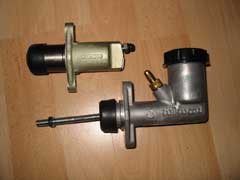
Esprit Clutch Cylinders
The Esprit Clutch system is a known weakness with older vehicles. With both the Master and Slave cylinders failing, causing owners problems. This isn't a big or expensive job as you might think. Parts aren't really expensive if you shop around and fitting can be done yourself. The Clutch Hose replacement is covered in a separate guide and having your actual Clutch replaced is also cover.
After my Esprit returned from having a new manifold, it lasted two days before something else was up (typical Esprit). My clutch pedal started to take a split second before it came back up after changing gear. Also travel became slightly shorter and the change was getting notchy (more than usual). This all happened on a short journey and once safely home the Esprit wasn't taken out again. I'd also lost most of the Clutch fluid in the master cylinder.
As I'd had a new PUK 35%+ Clutch fitted not long ago and had changed the Red Hose a lond while ago, this didn't leave much left. I knew it wasn't the gearbox as it wouldn't affect the clutch pedal travel when it wasn't in gear.
Next day I ordered a new Master and Slave cylinder from PNM Engineering. The Slave is a standard Lotus Part and is just over £50. The Master Cylinder is a PNM sourced Wilwood cylinder. This should be of a better quality than the standard Lotus Girling one and is £35 instead of £85. As both were in stock, I had them within two days.
I wasn't sure which was causing the problem, but was sure if I only changed the broken part the other part would soon give up. I'm pretty sure it was the master cylinder that was broken, either a failed seal for the springs can give up. You can buy service kits for repairing both cylinders, but for the price I didn't think it was worth it and decide to fit new parts. The slave is easy to change, the master was a little more difficult. Below is a basic guide to fitting.
Installation Guide
This is a job a little tougher than the hose replacement, about 4 hours depending on ability.
| Parts supplied by: |
 |
|
You will need the following parts: 1
new
Master Cylinder |
You will need the following tools: Jack
and axle stands |
SLAVE CYLINDER
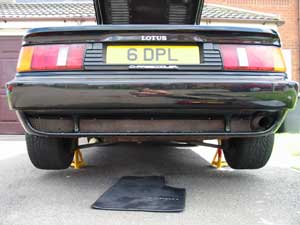
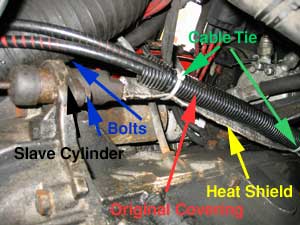

This is also covered under the 'Red Hose' Guide and I've used some of the pictures from that guide. First jack the rear of the Esprit up and secure with Axle stands. You'll be working on the Offside, but I raised the whole rear. Remove the Offside (drivers side for UK) wheel. The Slave Cylinder is located up behind the rear suspension. Remove the two 13mm bolts holding the slave to the side of the gearbox.
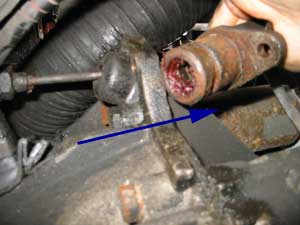
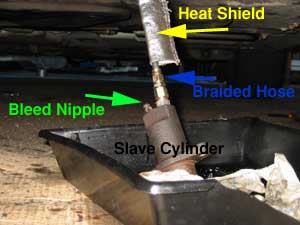
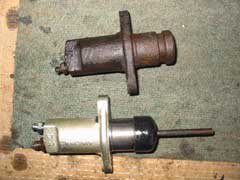
When you remove the cylinder, the bar and rubber seal will come away. You can now undo the hose (slowly) and bleed the system of Clutch fluid (remember this fluid will damage paint work, so be careful). If you are doing only the Slave Cylinder then you won't need to fully bleed the system, but I would recommend it, to replace with fresh clutch fluid.
Attach the new Slave cylinder to the hose and if you are only changing the Slave you can now bleed the system using the bleed nipple. You'll need another body to help you bleed, as pressure needs to be applied to the pedal. Once the system is bled you can reattach the new Cylinder. Grease will need to be applied where the bar meets the piston (under the seal). The bar (you'll be using the old one) and seal need to go through the other side of the mounting before you attach the new cylinder. Make sure you mount the cylinder with the hose at the bottom and the bleed nipple at the top, as if you need to bleed while the cylinder is on the car, you'll have trouble if it's upside down.
As you can see from above the Slave Cylinder bar needs to be set at a certain length. 22mm for Citroen gearbox's (pre 1987) and 12.5mm for Renault (post 1987). As I was using the old arm, I didn't need to change this. But do check while the bar is out.
MASTER CYLINDER
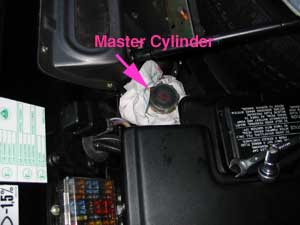
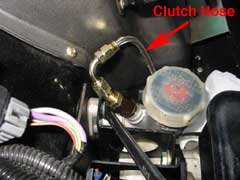
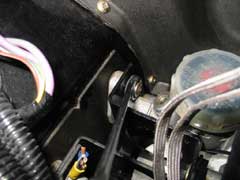
Removing the Master Cylinder is a little more involved than the Slave. The Master Cylinder is situated under the front bonnet of the car and is next to the ABS under the plastic cover and the brake master cylinder. You'll see the clutch hose coming up from the bottom of the car and attaching to the cylinder.
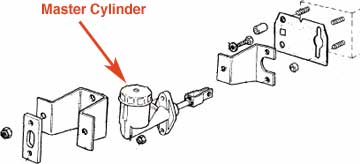
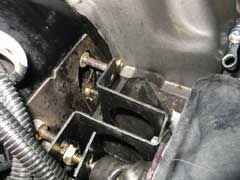
First thing to do is remove the clutch hose. Do this carefully as it will have plenty of clutch fluid in it if you didn't flush the system when fitting the slave. The Master is attach via two 13mm bolts, it is also held in via a metal plate that attaches to the brake servo. The plate needs loosening to release the master cylinder. A 15mm bolt holds the plate in position.
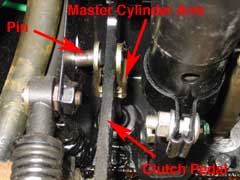
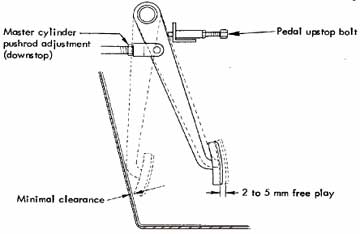
The Master cylinder pushrod will need to be disconnected from the clutch pedal to release the cylinder. So once in the Lotus position (head under the dash, legs up in the air), you see the rod coming through the bulkhead and attaching to the top of the clutch pedal. Please note that some pedal will have two holes, so make a note of which hole the rod is attached to for reconnection. The rod is attached with a clevis pin, which is held in place by a retaining pin. The pins are easy to remove, releasing the pushrod and in turn the Master cylinder.


Once you have the Master Cylinder out, you can fit the new one. To save having to set up the pushrod to the right length and attaching the fork to the new rod. I pulled out the Circlip on both cylinders and swapped the arms over, not forgetting to grease where the arm goes into the cylinder. Reattach the circlip and you have a new cylinder ready to go in.
Reattaching is easy, just push the cylinder back into place and secure the bolts. Then, in the Lotus Position once more, push the clevis pin through the fork and into the clutch pedal hole, secure with the retaining pin. This is a little tricky, as access is tight and your upside down, but it's shouldn't take too much swearing before it's done.
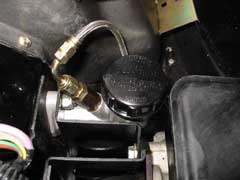
You can then tighten up all the bolts and attach the clutch hose. Fill the system with Dot 4 Clutch fluid and bleed the system at the slave cylinder to make sure there's no air in the system. You can then reattach the slave cylinder to it's mounting. You now need to check the clutch pedal. With the clutch pedal fully depressed and the master cylinder bottoming out, check the clearance between the lower edge of the clutch pedal pad (metal) and the body. If necessary, adjust the clutch master cylinder pushrod length to achieve a clearance of 2-5mm, ie, the pedal should just touch the carpet.
With the clutch pedal released, adjust the pedal upstop (if fitted), or discard if necessary to achieve 2-5mm upward free play on the pedal, ie the master cylinder is 'topping out'. If the master cylinder piston is restricted from reaching its full travel in either direction, clutch drag and/or slip will occur. You should now have a fully working, and new, clutch system.
LEW's Verdict
This is a job that will have to be done during an Esprits working life. I've heard to many failures of both Master and slave cylinders, due to age. Most of the time it will be the seals that wear and cause leakage from the system. As was mention earlier, you can purchase a service kit with new seals, but with PNM Engineering now offering an uprated Master cylinder for almost a third of the Lotus part, I'd recommend replacements.
As for the Wilwood master cylinder, it's hard to tell how much better it is than a genuine Lotus part (Girling). My cylinders were nearly 12 years old, so replacing them with new parts is always going to feel better. The pedal is now a lot smoother and lighter, with a little more feeling as well. I was amazed by it, as I thought I'd at least mess it up once, but no, first time and the system works like a dream. Considering how much this would cost from a dealer, using genuine parts and labour, this is definitely something that can be done yourself and save you money. If you still have a 'Red Hose' (and you shouldn't) this is the perfect time to upgrade the whole system. Yet another worthwhile modification on the Esprit!
![]()
This mod was performed by Lotus Esprit World on their 1992 SE
Clutch Fork Breakage
Previous investigations by Lotus into clutch fork failure resulted in three causes:• Fault with the clutch assembly resulting in high release loads
• Incorrectly adjusted clutch travel resulting in excessive movement of release bearing and the resultant overloading of the fork
• Incorrect location of the release fork locating spring on the pivotIf a release arm has broken it us likely that something else is wrong and just replacing the arm is not the solution - it is likely to fail again. Lotus would recommend that the clutch actuation is checked to identify what is wrong.
Another point is that we would not recommend a repair (welding) to the fork We have new parts in stock (approx.£90).
The ASO usage of this part is extremely low which suggests there isn't a major problem with this part.
Esprit Turbo Owner's Experiences
I just completed this on my 89 Turbo. The clutch master cylinder was leaking, so I decided to replace the hose (with a braided stainless steel upgrade) and the slave cylinder all at the same time.
I decided to follow in your footsteps, by using the push-rod from the old master cylinder. I gave it a good clean before attaching it. However, I found there was no need to remove the push-rod from the pedal, I simply removed the circlip on the old master cylinder and then attached the push-rod to the new cylinder. This was all done under the bonnet from within the front bay. Okay, it took 2 or 3 attempts to get the circlip in place on the new cylinder, there is not much space, but all in all it still only took 10 minutes - just be careful not to let the circlip shoot off or you might never find it again. What about the rubber cover I hear you say? Well, obviously you need to replace this on the push-rod before you attach the new cylinder. The old rubber cover was split anyway, so that was easy to come off. With a little grease and a screwdriver to hold the rubber hole open, it wasn't difficult to get the new rubber over the end of the push-rod and the retaining washer, and no I didn't split it.
With the slave cylinder, I did hit a problem that you didn't come across. Although it looked the same as the old cylinder, once I got the old one off the car and next to the new one, I could see they were different. For a start, the push-rod on the new item was almost twice as long as the old push-rod. Using the old push-rod was never going to be an option for me, it was just too crusty to be going back onto my car! Besides, in this case using the old push-rod wouldn't have worked, because the length of the piston chamber was also different between the old and new. I had to cut the new push-rod down, but also take into account the different in the piston length. With the push-rods in place, I held both cylinders and pushed the rods against a hard service to drive the pistons up the chamber as far as they would go. Then, I checked the difference between the flat surface (where the 2 bolts pass through) of the cylinder where it will mate to the gearbox. The difference between the two was the length I needed to cut off the new push-rod, to give the same amount of travel as the old cylinder set up.
I took the car for a 50 mile drive today and its all working fine, in fact its better than fine, its brilliant. The clutch pedal feels much more positive and gear change feels really smooth... honestly!
Thanks again for the inspiration.Colin.
User Info
April 2015
Thought I would share this with you since you demonstrated how to replace the master clutch cylinder and braided hose. I modified the bracket to the brake master cylinder on my 1991 Lotus Esprit SE. It made it possible for me to remove the clutch master cylinder without loosening the brake bracket to remove it just in case it happens again.
Works great ! Split the bracket then weld drill set collers to each half then used a .375" dia. pin to link it up. To take off remove pin take out one retaining bolt on brake bracket and two bolts on clutch master cylinder. I took Colin's advise and installed my new one from the top by leaving the existing retainer spring pin on the plunger. These help forums are a great tool.
Thanks
Randall Nichols
El Paso, Texas
rnichols@msdperformance.com
If you have any comments, feel free to e-mail me with at admin@lotusespritworld.com
|
|